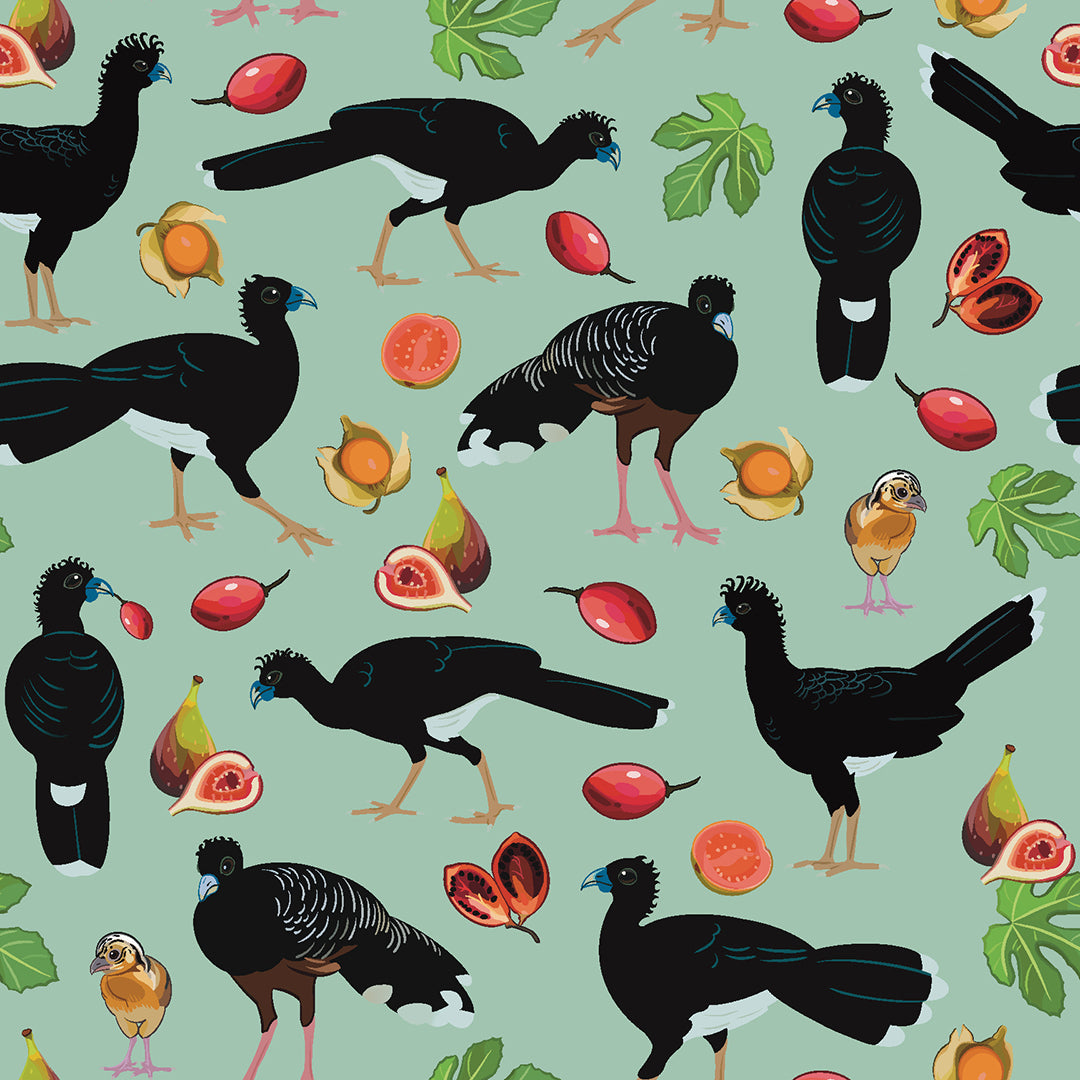By Heather S. Anderson, M.S.
September 2023
Blue-billed curassows (El Paujil in Spanish) are a medium-sized, ground-dwelling bird first described in 1850 by an English zoologist, Louis Fraser. He named the species Crax alberti after Queen Victoria’s Royal Consort, Prince Albert. At that time, the blue-billed curassows could be found throughout much of northern Colombia in South America. But now the blue-billed curassow is a critically endangered species, native to only five small pockets of forest in remote areas of the mountains of Colombia.[1] They are considered one of the rarest bird species in the world; population of remaining mature individuals is estimated at somewhere between 1,000 – 2,500.
Due to the blue-billed curassow’s critically endangered status they are exhibited in just a few AZA-accredited zoos within the United States, 16 institutions to be exact. Currently, there are only 74 individuals in US zoos, 17 individuals in Colombian zoos and 9 individuals in European zoos. Within those institutions, they are closely managed by a Species Survival Plan® Program Coordinator (International) to maintain genetic diversity while increasing the captive population number. This allows for additional study of the bird’s behaviors, husbandry, courtship and breeding patterns. It also means there is a protected population available in case a reintroduction of the species becomes necessary if and when laws, human behaviors and priorities change to allow the species to thrive in their native habitat again. Having a captive population also introduces and educates the public about a very rare bird species that needs human intervention now to ultimately survive.
Since blue-billed curassows were first described in 1850, loggers, hunters and pet traders took a heavy toll on the species population numbers.[2] Deforestation alone has eliminated about 98% of the blue-billed curassows’ habitat. By 1965 researchers reported that the species was becoming very rare. In that same year the Revolutionary Armed Forces of Colombia waged war with the government. The conflict lasted for the next 52 years (until 2017) and served as a reprieve for the blue-billed curassow population because the aforementioned threats could no longer access the remote areas the blue-billed curassow occupied. Without this conflict the species likely would have gone extinct in the wild.
As of 2003, in an attempt to counter the decline in natural habitat the U.S.-based Rainforest Trust and its Colombian partner, Fundacion ProAves bought 10,000 acres to save and protect the blue-billed curassows and all other species in this area. This area in the Magdalena Valley of Colombia has been established as the El Paujil (blue-billed curassow) Nature Reserve. It is a unique refuge of rainforest that’s millions of years old and has many endemic species found nowhere else. [3]
Blue-billed curassows are sexually dimorphic, meaning each sex exhibits different morphological characteristics (they look different). One morphological characteristic they have in common is a beautiful crest of specialized curly feathers atop their head. They can manipulate these curly crest feathers up and down and often use this to express themselves. The male’s body is mostly black with white feathers under his tail and up to the abdomen. Males also have white tips at the end of their tail feathers. The female’s body is mostly black with white barring across the feathers on her back, wings and atop her head. The feathers under her tail and up to the abdomen are a chestnut color. Females also have buff-colored tips on their tail feathers. [1] The chicks at hatching exhibit the chestnut color throughout their body feathers with some black barring on the back, wings and atop the head. This allows them to blend in with the ground better which makes them less visible to predators while the chicks are foraging for food.
The blue-billed curassows are a charismatic and curious species. They make unusual sounds, including a booming sound during breeding season which you can almost feel, like a radio with the bass turned up. [2] They also practice allo-feeding (feeding one another) which is one way they bond. This could be between males and females for pair bonding, the parents and young, or between clutch mates. These traits are shown in the video referenced below. [4]
The blue-billed curassow is an amazing bird species that I have been privileged to work with for over seven years. When I became a bird keeper, I was introduced to many bird species that I had never seen in person before. The blue-billed curassow is my favorite of all! During my first year of zookeeping I was afforded the opportunity to visit White Oak Conservation in Yulee, Florida. [5] At the time they had four to five pairs of blue-billed curassows and a couple of eggs approaching hatch. This was the first time I saw/heard a keeper whistle to an egg and the chick from inside reply! You read about this in books and on the Internet, but when you witness it in person it is truly a magical experience; to hear that chick answer from inside the eggshell and to feel its movement as you hold the egg!
As a chick grows inside the egg and gets close to hatching the air cell grows. The chick’s head enters the cell during hatch, allowing the chick to breathe air for the first time. With air in their lungs and air sacs they can now chirp and begin the laborious task of getting out of the shell. Chicks have an egg tooth (tooth-like protrusion at the end of their bill) that allows them to crack through the egg. They employ a zipper effect around the egg at the larger end. Then the chick pushes against that perforated end of the egg until it breaks loose and they pop out - they’ve hatched! [6] I have referenced a video of first experience at the National Zoological Park witnessing a Blue-billed curassow chick hatching below. [7]
The most amazing thing about the Blue-billed curassows is that they are one of a very few bird species which exhibit super-precociality. Most bird species are altricial, meaning they have no feathers at hatching and stay in the nest for 10 days or more. During this time the parents bring them food constantly. In contrast, precocial species of birds hatch out of the nest completely covered in down feathers and can eat on their own with little parental encouragement. Blue-billed curassows are one of only a very few bird species that are super-precocial. They have full-flight feathers at hatching (so they can fly once their feathers dry), learn to perch within hours and eat on their own, they do not have to be fed. Their parents just need to show them what is okay to eat and when to fly from danger. (An interesting point of reference is that the Pterosaurs were also capable of flight soon after hatching. Pterosaurs existed during the Mesozoic era and were the first vertebrate to evolve powered flight and the first reptile to fly, although they were not dinosaurs and not bird ancestors.) [8]
The story of the blue-billed curassows illustrates the importance of saving natural habitats around the world. Colombia’s habitat is crucial to the bird world. The country has the most bird species within its borders of any country on Earth. One-fifth of the world’s birds can be found in Colombia! There are approximately 10,000 bird species in total so that means Colombia has 2,000 species of birds alone. The blue-billed curassow is just one of them, but as one of the rarest species of birds in the world they are in urgent need of our help in order to survive and hopefully thrive for many, many years to come.
References:
[1] Delacour, J. & Amadon, D. 2004. Curassows and Related Birds. Second edition. Lynx Edicions and The National Museum of Natural History, Barcelona and New York.
[2] https://www.worldlandtrust.org/species/birds/blue-billed-curassow/
[3] https://news.mongabay.com/2017/11/will-the-bird-that-dodged-a-bullet-pay-the-price-of-peace/
[4] https://www.youtube.com/watch?v=9q1rR8PNbcw
[5] https://www.whiteoakwildlife.org/wildlife/blue-billed-curassow/
[6] https://www.sites.ext.vt.edu/virtualfarm/poultry/poultry_development.html
[7] https://www.youtube.com/watch?v=v1dJ32esO_E
[8] https://frontiersinzoology.biomedcentral.com/articles/10.1186/s12983-016-0185-6


